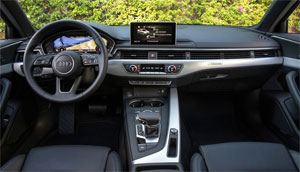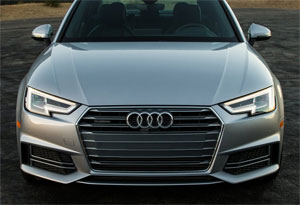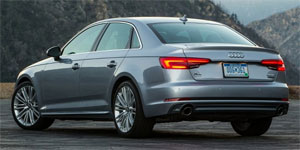2017 Audi A4
2017 is the first model year for the 5th generation of the Audi A4 sport sedan. But, wait a minute, if you throw in its Audi 80 ancestry, it’s actually the 9th gen b-series architecture for Audi. Regardless, over the years all those cars just keep getting better and better. So let’s find out if it’s b-car business as usual at Volkswagen’s premium brand.
The 2017 Audi A4 may be on the smaller side of four-doors, but it is both big-time polished and potent; boasting technology above any flagship luxury machine of 10-years ago.
That includes a Driver Assistance package with the latest safety technology; cameras to read road markings and even road signs, and of course automatic braking. So, you have to work pretty hard to crash it. We tried, but it stopped just shy of our barrier every time; applying the brakes in full, almost immediately after a warning chime.
As for interior technology, there is still a large MMI display on the dash; but it’s largely redundant if you opt for the huge 12-inch all-encompassing virtual gauge cluster as well as a new full color Head Up Display. With all pertinent info right before your eyes, and controls right there on the steering wheel; there’s no need to look or reach elsewhere.
 Those are just highlights of what is a fantastic interior, fully upholding the lofty standards we have for Audi.
Those are just highlights of what is a fantastic interior, fully upholding the lofty standards we have for Audi.
Leather seating is standard, and space is up over last year in all seating positions. Trunk space is very good at 13.0 cubic-ft.
Power sneaks up a little, with a revised 2.0-liter turbo-4 with 252-horsepower and 273 lb-ft. of torque for both front and all-wheel drive models. Now, that’s only 32 added ponies, but it feels like much more than that.
Possibly because weight is down slightly, but more likely because the 7-speed S-tronic dual-clutch transmission has been tightened up as well. No manual is available.
The exterior design is clearly an evolution of the previous A4, combined with style indicators from the larger A6-7 and 8. A4 suspension is 5-link independent all-around, with upgraded sport tuning available, as is adaptive damping, integrated into Audi Drive Select.
Our car’s optional, rear-biased quattro all-wheel-drive aids that sporty feel as well, with its self-locking center differential and selective torque control.
 With quattro, understeer is minimal, challenging the best of its rear-drive competition. And while the A4 has once again gotten bigger, it surely doesn’t drive like it. Though, we will stop short of saying its loads of fun to toss around; it’s more of a case of sterile mechanical precision.
With quattro, understeer is minimal, challenging the best of its rear-drive competition. And while the A4 has once again gotten bigger, it surely doesn’t drive like it. Though, we will stop short of saying its loads of fun to toss around; it’s more of a case of sterile mechanical precision.
Steering is very light at lower speeds, but firmed up quickly here at our track as the pace increased. After some slight lag off the starting block, the power eventually started getting put down in a smooth and steady fashion; ushering us to 60 in a fine 5.8-seconds.
There’s a nice growl from the engine, but not much from the exhaust, while the transmission keeps the gears coming quickly; clearing the 1/4-mile in 14.3-seconds at 99 miles-per-hour.
Braking was most impressive, a 104-foot average from 60; with rock steady stability and zero fade.
In everyday driving, everything about the A4 is smooth; as it absorbs bumps and pavement imperfections more like a full-size sedan than any compact. The dual-clutch tranny is mostly seamless, with the only hiccups coming during low-speed maneuvering.
Ride quality can be dialed to your liking, but even in full comfort mode, body control is well managed, and it never feels soft.
 The low seating position will not endear it to those crossover inclined, but visibility is excellent all around.
The low seating position will not endear it to those crossover inclined, but visibility is excellent all around.
Though very well-equipped in standard Premium trim, Prestige is where you want to be with 18-inch alloy wheels, S-line aluminum trim, and full LED lighting outside; along with Bang & Olufsen surround sound and heated seats for inside.
Government Fuel Economy Ratings are 25-City, 33-Highway, and 28–Combined, with our average coming in at a fine 29.1 miles-per-gallon of Premium. For an average Energy Impact Score, of 11.8-barrels of oil burned yearly, with C02 emissions of 5.2–tons.
Pricing starts at $35,850, that’s just a bit more than a base BMW 3-series, but significantly less than a base Mercedes-Benz C-class; Prestige trim with quattro however, will have you at $48,950.
And while those other German sport sedans are certainly the logical competition for the 2017 Audi A4. To us, it’s more in the spirit of the Cadillac ATS with luxury, performance, and technology addressed in equal balance. So, it is indeed business as usual; with another solid small-ish sedan from Audi.
Specifications
- Engine: 2.0 liter
- Horsepower: 252
- Torque: 273 lb-ft.
- 0-60 mph: 5.8 seconds
- 1/4 mile: 14.3 seconds @ 99 mph
- EPA: 25 mpg city / 33 mpg highway
- Energy Impact: 11.8 barrels of oil/yr
- CO2 Emissions: 5.2 tons/yr
2024 Toyota Land Cruiser
Toyota’s Go Anywhere Globetrotter Returns To U.S.
Every once in a while, we all need a reset. A time to get back to basics and prioritize the things that really matter. Well, for the Toyota Land Cruiser that time is now. So, let’s find out if that means bigger and better things for Toyota’s iconic off-roader.
The Toyota Land Cruiser’s status among the global off-road community is legendary, and it’s hard to imagine there’s any corner of the earth where a Land Cruiser hasn’t kicked up a little dust or mud. Well, 2024 sees the return of the Land Cruiser to the U.S. market after a 3-year hiatus, getting a major reset for the journey.
The reset comes mostly by no longer being based on the large three-row “300-series” chassis, but a new version of the smaller “200-series,” now known as the J250. As with the latest Tacoma, it uses the Tundra pickup’s full-size steel frame.
While the main Land Cruiser model, which goes by simply Land Cruiser, is packed full of luxury and convenience features, there is also a stripped-down model known as the 1958, honoring the first year the Land Cruiser made landfall here in North America. And it is that 1958 we have here, and we were glad to see it, as it also celebrates the original’s back-to-basics approach as a blank canvas for you to personalize as you tackle more and more adventures.
Not that it’s fully stripped down, as 8-inch touchscreen infotainment, a 7-inch full-color multi-information display, and automatic climate control are still standard. Plus, some seriously durable materials, and great heated cloth front seats that throw off some get serious 1990s Tacoma vibes.
But outside, there’s a definite lack of flashy trim and basic looking 18-inch wheels with Yokohama Geolander all-season tires; plus, big chunky bumpers and tilt-up back glass, which is a rarity that we appreciate. Though there is a little too much plastic in places that are sure to see some abuse if you do any significant off-roading.
It even feels a little rough around the edges, but for us it just adds to the rugged old-school utility vibe in a good way.
We did just that, both here in the Mid-Atlantic as well as in the California desert; and while there are some tech-forward driving aids, the actual hardware is in most cases plenty to get things done. That includes standard full-time dual-range four-wheel-drive, locking center and rear diffs, and 8.7-inches of ground clearance. A front stabilizer bar disconnect is also available to allow for increased articulation.
Who needs a V6 or even a V8 when you’ve got Toyota’s i-FORCE MAX setup at your disposal with 326 horsepower and 465 lb-ft of torque coming from a 2.4-liter turbo-four with an electric motor sandwiched between the engine and its eight-speed automatic transmission. Low speed torque delivery is impressive. It even feels a little rough around the edges, which may be a turn off to some, but for us it just adds to the rugged old-school utility vibe in a good way.
And it certainly feels quicker than an off roader needs to be, with an instant torque dump as soon as we eased on the throttle at our Mason Dixon test track; helping us get to 60 in 8.1 seconds and through the quarter-mile in 16.3 seconds at 86 mph. Considering the Land Cruiser’s terrain conquering mission, it behaved quite well in our handling course; it was plenty responsive to inputs, with less body roll than we expected and plenty of grip from the tires. The steering was light and quick but as expected didn’t provide much feel. Other than significant nosedive, braking performance was exceptional. Only 107-feet to panic stop us from 60 mph.
With the shift to the smaller size, there’s no more third row available, and cargo capacity now comes in at 46.2 cubic-feet with a max of a still healthy 82.1. Now, the best part of the Land Cruiser’s return is the entry price of $57,445. That’s about 30-grand less than what the last Land Cruiser went for back in 2021.
Whether it’s over the top fashion trends, mullets, or zombies; just when you think they’re dead, they come roaring back to life. Of course, we’re much happier to see the resurrection of this 2024 Toyota Land Cruiser than any of those things. Toyota is one brand that still recognizes the value of full-framed rugged rigs and has also acknowledged that sometimes less really is more. The Godfather of Toyota off-roading is back and better than ever.







